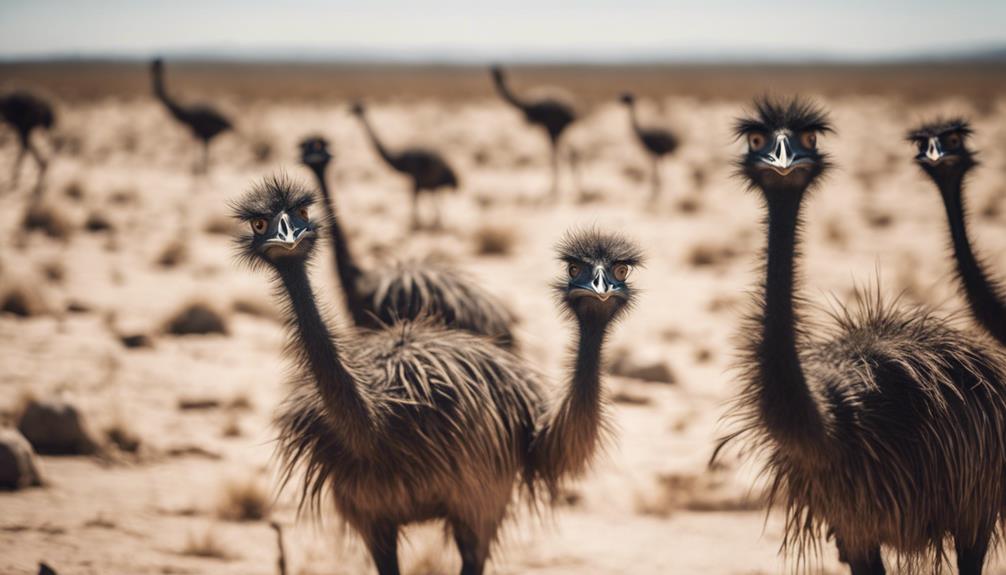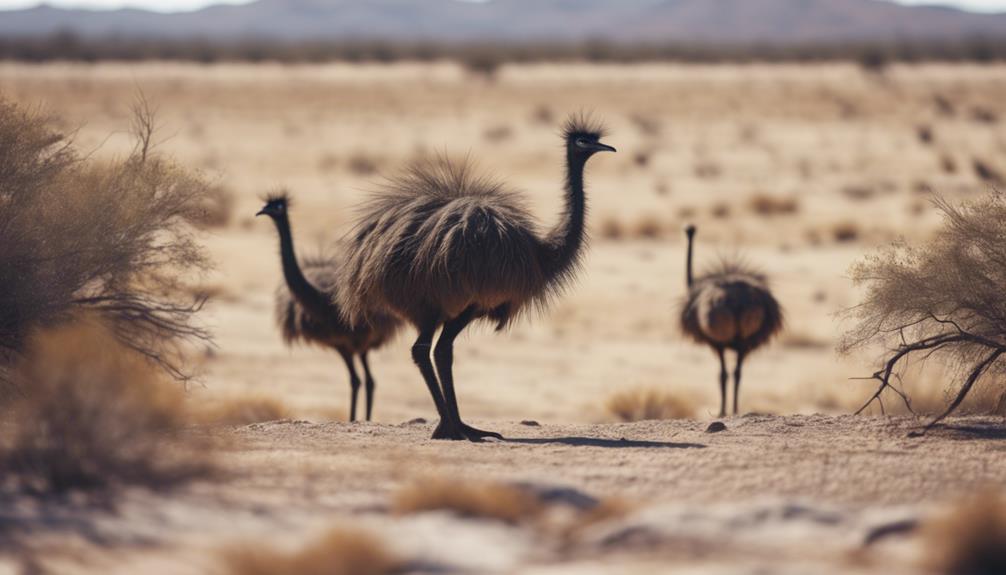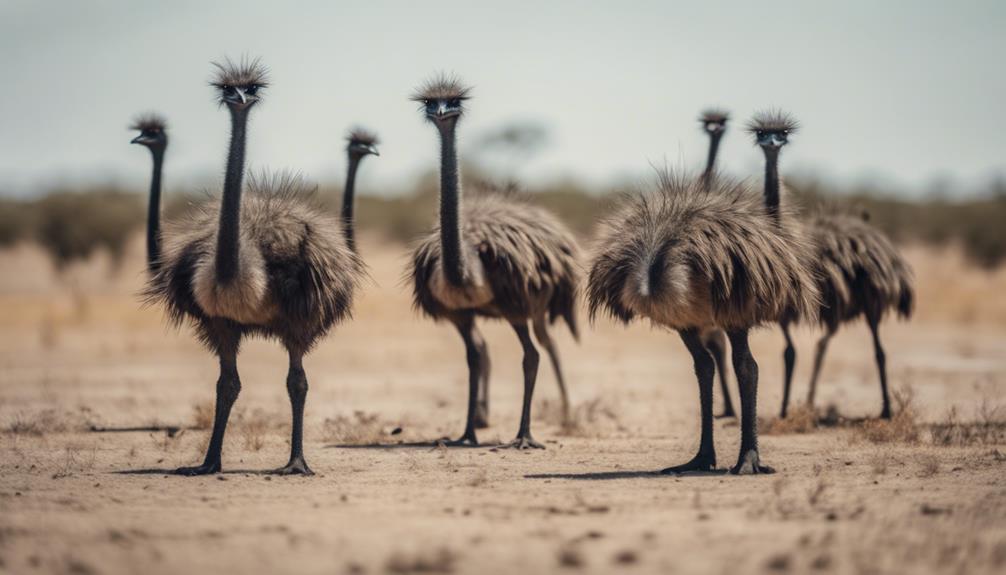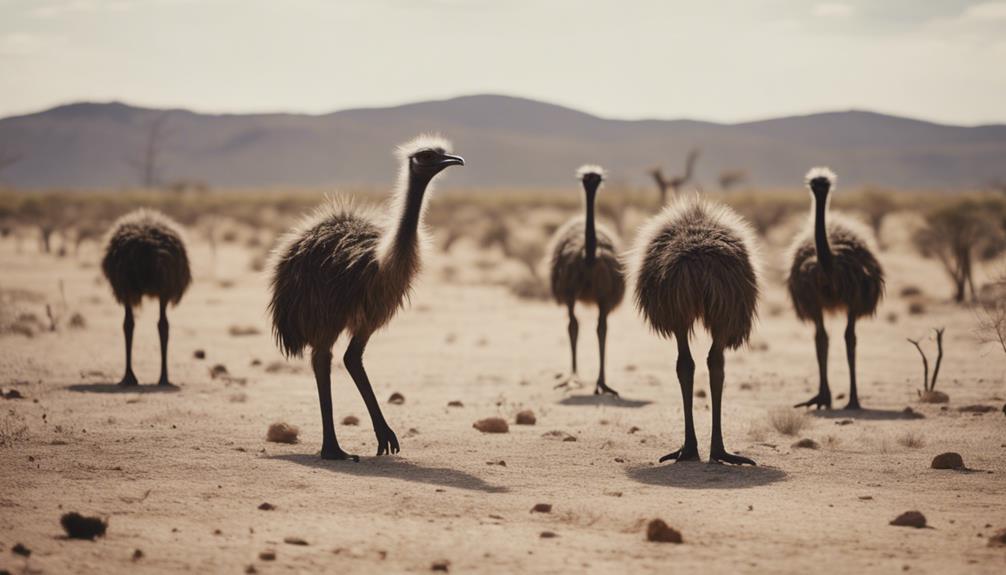
As you observe the gradual changes in the environment, have you ever considered how these shifts are impacting the majestic emu populations?
The effects of climate change on these iconic birds are far-reaching and multifaceted. From habitat loss to altered migration patterns, the challenges faced by emus are compelling.
Stay tuned to uncover the intricate web of consequences and explore potential solutions to ensure the survival of these unique creatures in the face of a changing world.
Key Takeaways
- Habitat loss threatens emus' survival and breeding.
- Climate change disrupts food sources, impacting nutrition.
- Genetic diversity is crucial for emus to adapt.
- Understanding migration shifts is vital for conservation.
Emu Habitat Loss

Emus are experiencing significant habitat loss due to human activities, leading to a decline in their population numbers. Habitat destruction from factors such as urbanization and agriculture has encroached upon the natural habitats where emus thrive. This loss of habitat disrupts their breeding and foraging patterns, making it harder for emus to find suitable areas for nesting and raising their young.
To combat this issue, habitat restoration projects play a crucial role in providing emus with safe spaces to inhabit and reproduce. By restoring degraded habitats and creating protected areas, we can help mitigate the impact of habitat loss on emu populations. Additionally, incorporating climate adaptation strategies into these restoration efforts is essential to ensure that the restored habitats remain resilient in the face of changing environmental conditions.
Food Source Disruption
The disruption of emus' food sources poses a significant challenge to their survival, impacting their ability to maintain healthy populations in the face of changing environmental conditions. Emus primarily feed on a variety of plants, seeds, insects, and small vertebrates, but alterations in their habitats due to climate change have led to foraging limitations and nesting disturbances. This disruption not only affects the emus directly but also indirectly through increased competition stress and hunting pressure.
To illustrate the impact of food source disruption on emu populations, consider the following table:
| Challenges | Description | Implications |
|---|---|---|
| Foraging Limitations | Reduced availability of food sources | Decreased nutrition and weakened emus |
| Nesting Disturbances | Disruption of nesting sites and breeding grounds | Lower reproductive success and population stability |
| Competition Stress | Increased competition for dwindling resources | Higher mortality rates and population decline |
| Hunting Pressure | Human exploitation due to scarcity of food sources | Further reduction in emu numbers |
These challenges highlight the intricate web of factors contributing to the vulnerability of emu populations in the face of food source disruption.
Breeding Challenges

Amidst changing environmental conditions, breeding challenges faced by emu populations are increasingly evident, impacting their reproductive success and overall population dynamics.
Emus rely on specific environmental cues for successful breeding, including rainfall patterns and food availability. Climate change-induced disruptions in these cues can lead to breeding failures, decreased reproductive success, and ultimately affect the genetic adaptation of emus to their changing habitats.
The timing of breeding seasons is crucial for emus, and alterations in the timing of food availability due to climate change can result in mismatches with peak reproductive periods. Such mismatches can lead to reduced reproductive success rates, lower chick survival, and overall population decline.
Emu populations are thus under pressure to adapt genetically to these changing conditions. Understanding these breeding challenges is vital for developing conservation strategies that can help mitigate the impacts of climate change on emu populations and ensure their long-term survival.
Migration Patterns Shift
Shifting in response to changing environmental conditions, emu populations are experiencing notable adjustments in their migration patterns. Emus, like many other species, are adapting to the alterations brought about by climate change and human activities. Here are some key factors influencing these shifts:
- Habitat Fragmentation: As human development continues to fragment emu habitats, these birds are forced to find new routes for migration.
- Weather Patterns: Changing weather patterns, such as increased droughts or severe storms, are prompting emus to seek more favorable conditions during their migrations.
- Resource Availability: Fluctuations in resource availability due to environmental changes are influencing the timing and duration of emu migrations.
- Environmental Conditions: Emus are adjusting their migration patterns in response to overall changes in environmental conditions that impact their survival and breeding success.
Understanding these migration pattern shifts is crucial for conservation efforts aimed at safeguarding emu populations in the face of ongoing environmental transformations.
Disease Vulnerability

In light of evolving environmental conditions, emu populations are increasingly vulnerable to diseases due to shifts in their habitats and behaviors. Disease resistance among emus is a critical aspect of their ability to combat pathogens. Emus have developed unique immune system adaptations over time, which have allowed them to thrive in their natural habitats. However, with climate change altering these habitats, the potential for exposure to new diseases is on the rise.
Emus possess a robust immune system that has enabled them to survive in various environments. Their disease resistance is a result of both genetic factors and environmental influences. As their habitats change, emus may encounter pathogens they haven't evolved to combat effectively. This shift in disease dynamics poses a significant threat to their populations.
Understanding the interplay between emu immune system adaptations and the changing disease landscape is crucial for conservation efforts. By monitoring disease vulnerability trends, researchers can develop targeted strategies to protect emu populations from potential outbreaks and ensure their long-term survival in the face of climate change.
Behavioral Changes
Emu populations undergoing habitat changes due to climate variations may exhibit noticeable shifts in their behavioral patterns, impacting their overall adaptability and survival strategies. These changes can significantly influence their reproductive success and social interactions.
Understanding the behavioral adaptations of emus in response to climate change is crucial for conservation efforts. Here are some key behavioral changes observed in emu populations:
- Altered Breeding Cycles: Emus may adjust their breeding seasons in response to changing environmental cues, affecting their reproductive success.
- Shifts in Foraging Behavior: Changes in food availability due to climate variations can lead to modifications in emus' foraging patterns, influencing their overall health and survival.
- Social Group Dynamics: Emus might alter their social structures and hierarchies to adapt to new environmental conditions, impacting their social interactions and group cohesion.
- Migration Patterns: Climate-induced habitat changes may prompt emus to modify their migration routes or destinations, affecting their movement patterns and resource utilization.
These behavioral adaptations highlight the resilience of emu populations in the face of environmental challenges, shedding light on their ability to cope with changing climates.
Population Decline

Experiencing a decline in their populations, emus face a pressing challenge exacerbated by the ongoing effects of climate change. The impact of climate change on emu populations is significant, with factors such as habitat loss, extreme weather events, and food scarcity contributing to this decline. Conservation efforts are crucial in mitigating these challenges and ensuring the survival of emus in the face of changing environmental conditions.
Climate change has led to shifts in vegetation patterns, reducing suitable habitats for emus. This, coupled with increased temperatures and changing rainfall patterns, disrupts the availability of food sources essential for emu survival. As a result, emu populations are dwindling in various regions where these changes are most pronounced.
Conservation efforts must focus on preserving and restoring critical emu habitats, implementing sustainable land management practices, and raising awareness about the importance of protecting these iconic birds. Collaborative initiatives involving scientists, policymakers, and local communities are essential in addressing the population decline of emus and safeguarding their future in the wake of climate change.
Genetic Diversity Impact
With the ongoing decline in emu populations exacerbated by climate change, the impact on genetic diversity is becoming a critical concern for the long-term survival of these iconic birds. Genetic diversity plays a vital role in the ability of emu populations to withstand environmental pressures and adapt to changing conditions over time.
- Evolutionary Adaptation: Genetic diversity is essential for the process of evolutionary adaptation, enabling emus to develop traits that help them thrive in their changing habitats.
- Conservation Genetics: Understanding the genetic makeup of emu populations is crucial for effective conservation efforts, as it allows researchers to implement strategies that preserve the species' genetic variability.
- Population Resilience: Higher genetic diversity enhances the resilience of emu populations, making them more resistant to diseases, habitat loss, and other threats.
- Long-Term Viability: Maintaining genetic diversity is fundamental for the long-term viability of emu populations, ensuring their ability to survive and evolve in the face of ongoing environmental challenges.
Conservation Efforts Needed

Efforts to conserve and protect emu populations necessitate a comprehensive approach that addresses the complex interplay of ecological factors and human impact. Two key strategies crucial for the conservation of emus are habitat restoration and community involvement.
| Conservation Strategies | Description | Importance |
|---|---|---|
| Habitat Restoration | Reviving natural habitats vital for emus to thrive, ensuring food sources and breeding grounds are preserved. | Essential for emus to maintain healthy populations and genetic diversity. |
| Community Involvement | Engaging local communities in conservation efforts through education, awareness programs, and sustainable practices. | Vital for garnering support, minimizing human disturbances, and promoting coexistence. |
Climate Resilience Strategies
To enhance the resilience of emu populations in the face of climate change, implementing adaptive management practices is imperative. Emus, like many species, are vulnerable to the effects of changing environmental conditions. By focusing on adaptation measures and promoting community involvement, we can work towards safeguarding these iconic birds for future generations.
Consider the following strategies:
- Habitat Restoration: Enhancing and restoring natural habitats can provide emus with the resources they need to thrive in a changing climate.
- Climate-Resilient Breeding Programs: Developing breeding programs that focus on resilience building can help ensure the long-term viability of emu populations.
- Education Programs: Educating the public about emus, their importance to the ecosystem, and the threats they face can foster a sense of stewardship and support conservation efforts.
- Collaborative Research Initiatives: Partnering with researchers and other stakeholders to gather data and monitor emu populations can inform effective conservation strategies.
Research and Monitoring Initiatives
Research findings indicate a need for enhanced monitoring initiatives to assess the impact of climate change on emu populations. Data analysis plays a crucial role in understanding how climate variations affect emu habitats and behaviors. By analyzing trends in temperature, precipitation, and habitat changes, researchers can pinpoint areas where emus may face the most significant challenges.
Technology integration is key to improving monitoring efforts. Utilizing satellite imagery, GPS tracking devices, and drones can provide real-time data on emu movements, habitat usage, and population dynamics. These technological advancements offer a more comprehensive and accurate picture of how emus are responding to environmental changes.
Effective data analysis combined with technology integration can help researchers identify potential threats to emu populations and develop targeted conservation strategies. By continuously monitoring emu habitats and behaviors, scientists can track changes over time and adapt conservation efforts accordingly. Embracing innovative monitoring initiatives is essential in ensuring the long-term survival of emu populations in the face of climate change.
Community Engagement Opportunities
Enhancing community engagement is pivotal in establishing a holistic approach to addressing the impact of climate change on emu populations. Public education plays a crucial role in raising awareness about the challenges faced by emus due to climate change. By providing informative sessions and materials, individuals can better understand how they can contribute to conservation efforts.
- Volunteering opportunities allow community members to actively participate in initiatives aimed at protecting emu habitats and promoting sustainable practices.
- Policy advocacy is essential for influencing decision-makers to implement regulations that safeguard emu populations and their ecosystems.
- Outreach campaigns help spread information to a wider audience, encouraging more people to get involved in conservation efforts.
Engaging with the community through these avenues fosters a sense of collective responsibility and empowers individuals to take meaningful action. By mobilizing public support and involvement, we can work together to mitigate the impact of climate change on emus and ensure a sustainable future for these remarkable birds.
Frequently Asked Questions
How Do Climate Change-Induced Changes in Emu Behavior Impact Their Interactions With Other Wildlife Species in Their Ecosystems?
When climate change alters emu behavior, it affects their interactions with other wildlife. As predator-prey dynamics shift and competition increases, habitat fragmentation plays a key role in reshaping species interactions within ecosystems, showcasing the delicate balance at stake.
What Specific Adaptations Are Emus Developing in Response to Shifting Migration Patterns Caused by Climate Change?
As emus face shifting migration patterns due to climate change, they are showing remarkable evolutionary responses. From behavioral changes to habitat modifications and shifts in food sources, these adaptations highlight their resilience in a changing world.
How Are Emus Coping With Increased Disease Vulnerability Due to Changing Environmental Conditions?
To cope with increased disease vulnerability due to changing environmental conditions, emus exhibit behavioral changes like altering foraging locations, reducing contact with infected individuals, and enhancing grooming habits. These adaptations contribute to improved disease resistance.
What Are the Potential Long-Term Effects of Reduced Genetic Diversity in Emu Populations as a Result of Climate Change?
To understand the potential long-term effects of reduced genetic diversity in emu populations due to climate change, it is crucial to examine genetic resilience for climate adaptation and its impact on population dynamics and biodiversity conservation.
How Can Individuals and Communities Actively Support Emu Conservation Efforts in the Face of Climate Change Challenges?
To support emu conservation amid climate challenges, engage in community initiatives and fundraisers. Get involved in educational outreach and volunteer opportunities. Your actions directly impact the survival of these unique birds. Join the effort!
Conclusion
As climate change continues to impact emu populations, habitat loss, food source disruption, breeding challenges, and shifting migration patterns pose significant threats.
Conservation efforts are crucial to protect these iconic birds from further decline. By implementing climate resilience strategies, conducting research and monitoring initiatives, and engaging with communities, we can work towards ensuring the survival of emus in the face of environmental challenges.
The data shows a clear need for action to safeguard these unique creatures for future generations.




